
Almeria
- Mojácar |
|

| Mojácar
- A very picturesque and romantic resort town in Almería province,
south-eastern Spain. The streets are cobbled and the houses white-washed,
situated on a hill overlooking clean, sandy beaches and the warm, blue
Mediterranean sea. The town is an ancient, Moorish fortress which is unspoilt
and a favourite venue for artists and writers, plus holiday-makers. |

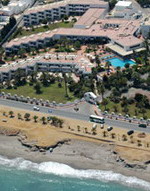 |
Parador
of Mojácar, Mojácar, Almeria
On the Mojácar coast,
with the best micro-climate in Spain, the Hotel offers gorgeous views of
the blue Mediterranean. The ideal spot to enjoy these quiet beaches or
to let sport bring you into contact with nature. The hotel reopened
its doors in the summer of 2008 after a complete renovation of its facilities.
Warm colours, the comfortable and cosy atmosphere of its rooms and improved
exteriors in all respects beckon you to visit. Your stay can be rounded
off with a refreshing dip in the hotel pool or working in the well-equipped
rooms of the magnificent conference centre. The bright rooms with terraces
over the sea invite guests to enjoy the enchanting beauty of their surroundings.
We recommend you try the exquisite fish and rice dishes of the cookery
of Almería |
 
Cádiz |
|

| Cádiz
- The Costa de la Luz (Coast of light) is the western part of the Andalucía
coastline that faces out to the Atlantic - the coastline of the province
of Cádiz. Cádiz is
among the oldest settlements in Spain, founded about 1100 BC by the Phoenicians
and one of the country's principal ports ever since. Its greatest period,
however, and the era from which the central part of town takes most of
its present appearance, was the eighteenth century. Then, with the silting
up of the river to Sevilla, the port enjoyed a virtual monopoly on the
Spanish-American trade in gold and silver, and on its proceeds were built
the cathedral - itself golden-domed (in colour at least) and almost Oriental
when seen from the sea - the public halls and offices, and the smaller
churches. |

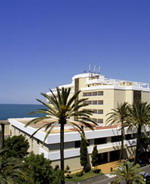 |
Parador
of Cádiz, Cádiz 
A
modern holiday complex located in Cadiz’s old town next to the Genovés
park. It overlooks the sea with a spectacular view over the Gaditana bay.
It is in the residential zone of the city, surrounded by palm trees. The
hotel is an ideal starting point for exploring the entire region; from
here you explore the Ruta de los Pueblos Blancos (tour of the white villages),
the bull and wine routes, as well as the fishing villages dotted along
its extensive coastline. There are many activities you can take part in
outside of the hotel including boat trips or tours of the region. During
the summer the hotel also organises entertainment for adults: ballroom
dancing to a live orchestra, magic shows, live music and various other
shows every day of the week, as well as children’s entertainment. In winter
there are live piano recitals to liven up the evenings. |
 
Cádiz
- Arcos de la Frontera |
|

Spain's
Prettiest town: Arcos de la Frontera
Deep in the south of Spain's southernmost
province, Cadiz, hidden in the Gatidano mountain range, is Arcos de la
Frontera the prettiest town in Spain. Although the old walled town of Arcos
only holds 4000 people & is lost in a valley hidden in the mountains,
its place in Spanish history is important because of the town's strategic
placement in Catholic Spain's long struggle against the Moorish kingdom.
Boabdil, the last Moorish king, finally fell in 1492, the same year Columbus
sailed west for India. At Cadiz's tip, near Arcos de la Frontera, Africa
looms large across a bit of water that seems a mere swim away... read
more |

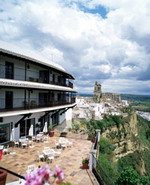 |
Parador
de Arcos de la Frontera, Arcos de la Frontera, Cádiz 
Located
on the banks of the Guadalete, this parador, formerly the Casa del Correidor,
has an impressive panoramic view of the fertile plain of the river and
of the old part of Arcos de la Frontera. The ample rooms are decorated
in Andalusian style, some even have a tiled stone-seat. Some rooms have
a terrace with views to the river and the rest to the main square or the
town church. All of them are fully equipped including full bathroom.
The restaurant is a large room with wide windows overlooking the river.
It features wooden beams, white arches, typical lanterns, solid wooden
chairs and tables covered by white tablecloths. In a friendly atmosphere
the restaurant offers the characteristic dishes of the Sierra region... |
 
Córdoba,
Córdoba Province |
|

| CÓRDOBA lies upstream
from Sevilla beside a loop of the Guadalquivir, which was once navigable
as far as here. It is today a minor provincial capital, prosperous in a
modest sort of way. Once, however, it was the largest city of Roman Spain,
and for three centuries it formed the heart of the western Islamic empire,
the great medieval caliphate of the Moors. It is from this era that
the city's major monument dates: the Mezquita , the grandest and most beautiful
mosque ever constructed by the Moors in Spain. It stands right in the centre
of the city, surrounded by the old Jewish and Moorish quarters, and is
a building of extraordinary mystical and aesthetic power. |

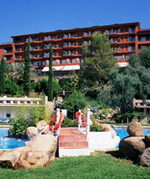 |
Parador
of Córdoba, Córdoba
Located
on the ruins of the small summer palace of Adderraman I, a hill surrounded
by vegetation at the foot of the Cordoba mountain range. The parador offers
an exceptional panoramic view of the legendary city of the Calips.
The rooms are bright; most of them with views to the city. All rooms are
very well looked after and are fully equipped and spacious. Regarding
cuisine, the restaurant's most typical dishes are el gazpacho de almendras
(a cold vegetable soup) los huevos esparragaos (an egg dish), el estofado
de rabo de toro (a meat stew), el pastel cordobes, and the cheese of los
pedroches. The Parador is located in the foothills of the Cordoba mountains
in the residential district of Brillante. |

Granada
- Alhambra |
|

| If you see only one town in Spain
it should be GRANADA. For here, extraordinarily well preserved and
in a tremendous natural setting, stands the Alhambra - the most exciting,
sensual and romantic of all European monuments. It was the palace-fortress
of the Nasrid sultans, rulers of the last Spanish Moorish kingdom, and
in its construction Moorish art reached a spectacular and serene climax.
But the building seems to go further than this, revealing something of
the whole brilliance and spirit of Moorish life and culture... |

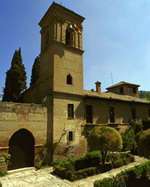 |
Parador
de Granada
Spend
a night at the site of the Alhambra, among gardens and fountains which
recall a past where the Arabian merged with the Christian. This is the
exclusive opportunity this Parador affords us, an ancient convent built
on the orders of the Catholic Monarchs on top of a Nazrid palace, of which
important remains are still conserved, such as the Nazrid Hall. This monumental
complex offers the guest peaceful walks around the area and the city, while
the building itself and its gardens invite you to discover a fantasy-like
interior. Numerous works of art and exceptional pieces of furniture decorate
the Cloister and the interior rooms. There are magnificent views
from both the dining room and terrace over the Generalife gardens, with
succulent dishes such as Granada remojón (Cod with orange and olives),
beans with ham, Santa Fe piononos, choto veal and, of course, typical local
Andalusian gazpacho. Full of vitamins! |

Huelva
- Ayamonte |
|

| Ayamonte is a town and municipality
located in the province of Huelva, Spain. According to the 2005 census,
the city has a population of 18,001 inhabitants. The township of
Ayamonte preserves its old medieval quarter in the central district of
the town, with many very narrow streets and historical buildings; this
central area is a designated car-free zone. For centuries the ferry
link between Ayamonte and Vila Real de Santo António was the traditional
crossing point between Spain and Portugal. A modern bridge over the Guadiana
River has now been built to the north of the town, linking the motorway
systems of the two countries, but the ferry still runs and provides an
inexpensive mode of transport between the two countries.
The beach area of Ayamonte is Isla
Canela, and is reached by a causeway across the Marismas del Guadiana;
the marismas (salt marshes) are an important wildlife reserve, providing
a home to many waterfowl, including herons and flamingos. Isla Canela is
built along several kilometers of sandy beaches, and provides an ideal
area for windsurfing, kitesurfing and sailing. There are a number of quality
golf courses in and around the area, including one built into the Marismas
itself. It is well known as the home of young Spanish idol, María
Isabel. |

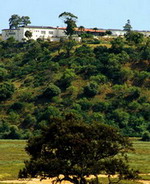 |
Parador
of Ayamonte, Ayamonte, Huelva
Vantage
point above the mouth of the river Guadiana - The dazzling sun of the Huelva
province brings out the blue in the river Guadiana as it follows its course
towards the Atlantic Ocean. A peaceful haven in the highest part of the
city with a spectacular view, the Parador is an ideal place for relaxing.
The hotel's interior rooms make use of the region's sun, decorated in a
modern style with simple shades, creating a pleasing sensitivity.
The local fish, seafood and sausages are highly recommended. The prawns
and king prawns from Huelva are renowned worldwide for their high quality.
You can enjoy dishes such as raya en pimentón (skate in a red pepper
sauce), rape en amarillo (saffron monkfish), estofado de guisantes con
chocos (cuttle fish and pea stew) and coca ayamontina (almond flavoured
dessert), not to mention the delicious Huelva ham. |

Huelva
- Mazagón |
|

| Mazagón is a beach
town in Spain near Huelva. |

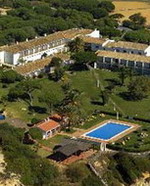 |
Parador
of Mazagón - Huelva Province
Located
in the Entorno de Doñana Natural Park, the Hotel stands in front
of the ocean next to the extensive Mazagón beach, in the middle
of a pine forest. A perfect place to enjoy the nature and the blue waters
of the Atlantic. The building has a splendid garden with heated open-air
swimming pools, a gymnasium, sauna, jacuzzi, etc. The interior is
characterised by pleasant, cosy spaces with decorative details that add
joy and brightness. Cosy rooms with terraces and beautiful views, comfortable
function rooms and a magnificent swimming pool round off its facilities.
The privileged setting of the Parador allows it to offer produce from the
sea and the mountains. From the first, the prawns, clams and king prawns
are recommended. From the inland, the jabugo ham, the steak and the Iberian
pâtés. |

Jaén,
Jaén Province |
|

| Jaén is a city in
south-central Spain. It is the capital of the province of Jaén.
It is located in the autonomous community of Andalusia. The inhabitants
of the city are known as Jiennenses. Its population is 117,540 (2006),
about 1/6 of the population of the province. In the last years Jaén
has had a great increase of cultural tourism. Jaén is also known
as the World Capital of Olive Oil, because it's the biggest producer of
this liquid gold (as the locals refer to it). The urbanism of Jaén
is determined by its adjustment to the hills of the Santa Catalina mountains,
with steep, narrow streets, in the historical central city district. The
city of Jaén is the administrative and industrial centre for the
province. Industrial establishments in the city include chemical works,
tanneries, distilleries, cookies factories and textile factories. |

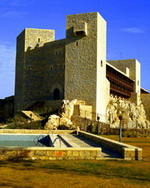 |
Parador
of Jaén, Jaén
Exceptional
18th Century Arabic Fortress - The hotel's privileged location on the Cerro
de Santa Catalina adds a defensive, fortress-like character to the Jaén
landscape. With a refreshing swimming pool and exterior stonework
that soaks up the sun, the hotel promises to enchant you with a full experience
of the Andaluz Renaissance. The building's majestic appearance continues
inside with the impressive 20 metre high arches in the main hall, the dining
room with its distinctive Arabic character, and the comfortable bedrooms
with their magnificent views. The soft interior decoration of the
building is complemented by a varied gastronomic menu. Try our ajo
blanco, an exquisite dish made with garlic, oil, almonds and bread. And
do not miss the terrina de perdiz (partridge terrine), the pipirrana (typical
salad) and the ciervo al estilo de Baños (venison). |

Jaén
- Cazorla |
|

| Cazorla is a city located
in the province of Jaén, Spain. According to the 2006 census (INE),
the city had a population of 8,173 inhabitants.
Cazorla lies at an elevation of 836
metres on the western slope of the Sierra de Cazorla. It is the entry point
and base for visits to the Natural Park of Sierras de Cazorla Segura y
las Villas, a vast protected area of magnificent river gorges and forests.
Spain's second longest river, the Guadalquivir has its source in the mountains
to the south of the settlement. Distances to nearby cities are: Jaén,
121 km.; Granada, 205 km.; and Linares, 71 km.
The town is constructed around three
main squares, the Plaza de la Constitución, the Plaza de la Corredera
(or de Huevo, "of the Egg", because of its shape), and the Plaza Santa
Maria. This last square is the oldest and is connected to the other two
by narrow, twisting streets. It takes its name from the old cathedral which,
damaged by floods in the seventeenth century, was later burnt by French
troops. It is now in ruin. Above the square sits an austere, reconstructed
Moorish castle tower called la Yedra. Still higher up on the rocky escarpment
lie the ruins of still yet another ruined fortress.
A recommended excursion is to the
nearby village of la Iruela which has a ruined Moorish fortress perched
on a daunting rock peak. A number of battles were fought here during the
Reconquest until Don Rodrigo Jimenez de Rada, archbishop of Toledo, reconquered
it in 1231 and made it the seat of his archbishopric. Its primitive
structure is relatively intact. The principal defenses consist of a crumbling
principal tower and two separate enclosures, with some of its battlements
still intact, connected by a long curtain wall. These walls also protected
the monastery, whose remains are still visible nearby. See Castles
The history of Cazorla goes back
more than two thousand years. Under the Romans the town had the name of
Carcacena. Not only were there significant Iberian and Roman settlements
here, but this was also the see of one of the first bishoprics of early
Christian Spain. Under the Moors it was a strategic stronghold and one
of dozens of fortresses and watchtowers guarding the mountains. Taken after
a bitter struggle in 1235, during the Reconquista, the town then acted
as an outpost for Christian troops.
Today Cazorla is heavily dependent
on tourism and hosts events such as the Cazorla Blues Festival each July.
There is also production of high-quality olive oil from the one third of
municipal land planted in olive trees. There is even a publication, The
Olive Oil Gazette, which is published in Cazorla. Sierra de Cazorla is
the Denomination of Origen for this olive oil. See Sierra de Cazorla. The
town celebrates its annual fair in mid-September. For such a small
town there are a surprising number of three and four star hotels and countless
rural guest houses. Winter nights can be cold due to the elevation
but snow is infrequent. Summers are cooler than the low-lying plains to
the west and the town fills with tourists during the summer months. |

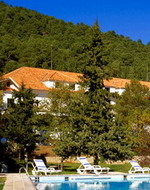 |
Parador
of Cazorla, Cazorla, Jaén
Charming hotel in the heart
of nature - The Hotel is located in the Heart of Cazorla Nature Reserve,
in the spot known as Sacejo. Its high location means it benefits from unbeatable
panoramic views over the surrounding area with its abundance of pine-filled
hillsides typical of the mountains. The quiet atmosphere and beautiful
enclaves such as Cañada de las Fuentes or Linarejos waterfall make
it a meeting spot for nature lovers. The hotel follows typical Andalusian
farmhouse tradition, highlighted to the exterior. The swimming pool has
marvellous views out over the Nature Reserve and the pleasant lounge with
its chimney breast to the inside is characterised by the bright light streaming
in through the large windows. Seasonal game forms part of the cuisine available
at the restaurant with dishes such as wild boar in red wine and grilled
venison fillets. |

Jaén
- Úbeda |
|

| Úbeda is a town in
the province of Jaén in Spain's autonomous community of Andalusia.
It has 34,462 (INE 2008). Both this city and the neighboring city of Baeza
benefited for extensive patronage in the early 16th century resulting in
the construction of a series of Renaissance style palaces and churches,
which have been preserved across the centuries. In 2003, UNESCO declared
the historic cores and monuments of these two towns a World Heritage Site. |

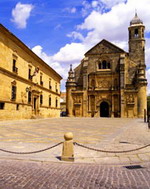 |
Parador
of Úbeda, Jaén Province
16th
Century renaissance palace - in the aristocratic, monumental city of Úbeda,
in its purest Renaissance plaza and next to some of its most beautiful
buildings, the Parador occupies a palace, built in the 16th century and
remodelled in the 17th, which once belonged to the Dean of the Holy Chapel
of the Saviour. Behind the façade is a very beautiful inner
courtyard, with a double gallery, the upper tier of which is glazed. The
comfortable and welcoming rooms are remarkable for the height of their
ceilings. Particularly outstanding are the six looking onto the plaza,
and the suite on the opposite corner, with panoramic views of the Plaza
de Vázquez de Molina. Sit down in the Parador’s dining room,
take up a menu and enjoy. Bull’s tail in loma red wine, stewed kid with
pine nuts, peppers stuffed with partridge… Whatever you order, success
is assured. Andalusian details and ceramics decorate the dining room. |
Browse
more paradores in Andalucia
Top
|

